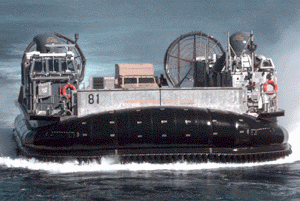LCAC (Landing Craft Air Cushioned)* |
| Air cushion craft are for for
transporting, ship-to-shore and across the beach, personnel, weapons,
equipment, and cargo of the assault elements of the Marine Air-Ground Task
Force.
The landing craft air cushion (LCAC) is a high-speed, over-the-beach fully amphibious landing craft capable of carrying a 60-75 ton payload. It is used to transport weapons systems, equipment, cargo and personnel from ship to shore and across the beach. The advantages of air-cushion landing craft are numerous. They can carry heavy payloads, such as an M-1 tank, at high speeds. Their payload and speed mean more forces reach the shore in a shorter time, with shorter intervals between trips. The air cushion allows this vehicle to reach more than 70 percent of the world's coastline, while conventional landing craft can land at only 15 percent of the coasts. |
 |
It can travel more than 40 knots (46 mph) with a full payload in calm water. At this speed, it has a range of 200 miles. At slower speeds, it can travel 300 miles.
Ambulatory casualties can travel in the built-in compartments. Litter patients must ride in specially-configured medical evacuation compartments placed in the cargo hold. When properly configured, up to 100 litter patients can be carried in this way. Litter patients cannot be placed in the open deck of an LCAC because it is exceedingly noisy and wet (a considerable amount of spray comes over the deck in anything other than absolutely calm seas).
In addition to the usual pitching and rolling associated with other landing craft, LCAC's are somewhat unstable, resulting in some degree of crabbing. This combination can be nausea-producing in even the acclimatized individual. It is worse at higher speeds and worse in choppy seas.
*From Operational Medicine 2001, Health Care in Military Settings, NAVMED P-5139, May 1, 2001, Bureau of Medicine and Surgery, Department of the Navy, 2300 E Street NW, Washington, D.C., 20372-5300
Contents · Introduction · Learning Objectives · Textbook · Lectures · Procedures · Final Exam · Library · Laboratory · Pharmacy · Imaging · Forms · Videos · Search · About the Author · Contact Us
Military Obstetrics & Gynecology
© 2005
Medical Education Division,
Brookside Associates, Ltd.
All rights reserved